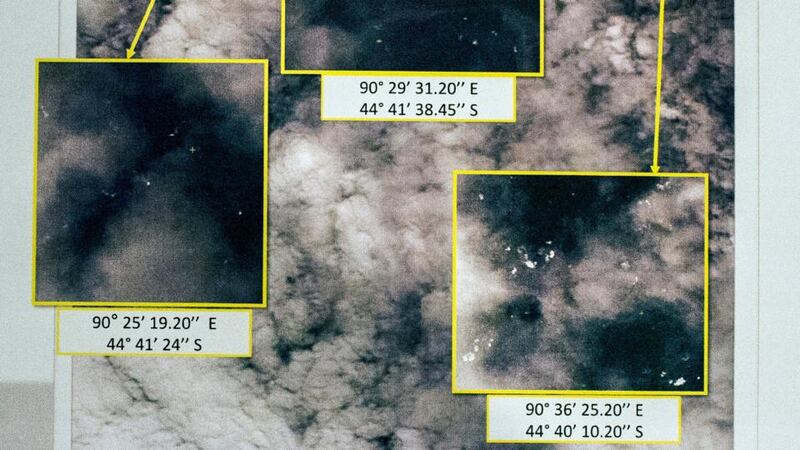New satellite images have revealed more than 100 objects in the southern Indian Ocean that could be debris from a Malaysian jetliner missing since March 8th with 239 people on board, Malaysia’s acting transport minister said today.
Hishammuddin Hussein told a news conference that the images were captured by France-based Airbus Defence & Space on Monday and showed 122 potential objects in a 400 sq km area of ocean.
The objects varied in size from one metre to 23 metres (75 ft) in length, he said.

They are the fourth set of satellite images to show potential debris from Malaysia Airlines Flight MH370 in a remote part of the Indian Ocean roughly 2,500 km south west of Perth.
No confirmed debris from the Boeing 777 has yet been identified.
Meanwhile US equipment designed to detect black box signals arrived in Australia today.
A dozen aircraft from Australia, the United States, New Zealand, China, Japan and South Korea were once more scouring the seas in the hunt for wreckage, after bad weather yesterday forced the suspension of the search.
"The crash zone is as close to nowhere as it's possible to be but it's closer to Australia than anywhere else," Australian prime minister Tony Abbott said, before leading the country's parliament in a moment's silence.
“A considerable amount of debris has been sighted in the area where the flight was last recorded. Bad weather and inaccessibility has so far prevented any of it from being recovered. But we are confident that it will be.”
Malaysian prime minister Najib Razak this week confirmed that Malaysia Airlines Flight MH370, which vanished while flying to Beijing from Kuala Lumpur, had crashed in the southern Indian Ocean.
Citing satellite-data analysis by British company Inmarsat , he said there was no doubt the Boeing 777 came down in one of the most remote places on Earth - an implicit admission that all 239 people on board had died.
Recovery of wreckage could unlock clues about why and how the plane had diverted so far off course in one of aviation’s most puzzling mysteries.
Theories range from a hijacking to sabotage or a possible suicide by one of the pilots, but investigators have not ruled out technical problems.
An Australian navy ship returned to the area after being driven away by gale force winds and 20-metre waves yesterday, while a Chinese icebreaker and three Chinese navy vessels are now in the search zone.
Finding the so-called black boxes - the cockpit voice recorder and flight data recorder - is crucial. They record what happens during flight, but time is running out to pick up locator beacons that stop about a month after a crash due to limited battery life.
The prolonged and so far fruitless search and investigation have taken a toll, with dozens of distraught relatives of Chinese passengers clashing with police in Beijing yesterday, accusing Malaysia of “delays and deception”.
Malaysia’s confused initial response to the plane’s disappearance and a perception of poor communications has enraged many relatives of the more than 150 Chinese passengers and has strained ties between Beijing and Kuala Lumpur. Chinese special envoy, Zhang Yesui, is meeting with Malaysia’s Najib on Wednesday, state media reported.
Flight MH370 vanished from civilian radar screens less than an hour after taking off on March 8th and investigators believe someone on the flight may have shut off the plane’s communications systems.
Partial military radar tracking showed it turning west and recrossing the Malay Peninsula, apparently under the control of a skilled pilot.
The air crash investigation is shaping up as one of the most costly and difficult ever.
Agencies











